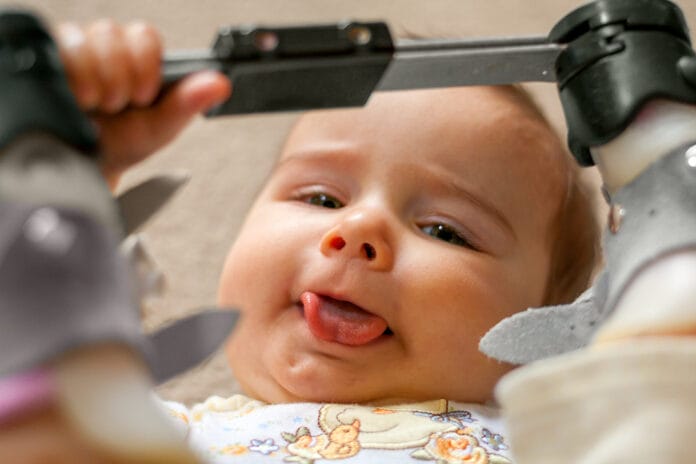Jake had the longest tongue I’d ever seen, and his tongue could find a face at a moment’s notice. His tongue had a full range of motion, which is what every tongue should have. By the way, Jake was a Maltese/poodle canine.
Dogs are not the only mammals that should have a good range of motion when it comes to the tongue. Tongues are often not properly evaluated early enough and can cause lifelong problems.
A real issue many parents don’t consider is the infant’s tongue or the attachment in which the tongue is fastened to the floor of the mouth. This is known as a tongue-tie (ankyloglossia) and is defined as a lingual frenulum that is short, tight, and restricts normal tongue movement. Typically, the lingual frenulum separates before birth, allowing the tongue to have a free range of motion. With a tongue-tie, the lingual frenulum remains attached to the bottom of the tongue.
Why this happens is largely unknown, although some cases of tongue-tie have been associated with the gene mutation on the X-chromosome.1,2
The Big Deal
The movement of the tongue is important for not only latching to nurse but in the development of the oral cavity and growth of the face. In the hospital, infants are evaluated from head to toe. One evaluation is of the tongue. If an infant is found to have a restriction, the parents are informed and given the option to release the tongue.
Even though my own children did not have a tongue restriction, many patients inform me that their children do have a restriction, yet decided not to have the release performed due to the perceived painful experience for the child or thinking it wouldn’t pose a problem. I’ve learned from discussions with those parents that information they received at the hospital is often incomplete, or perhaps the new parents were so overjoyed that some of the information was lost. What parents don’t seem to understand is the lifelong effects of a tongue tie.
The tongue is responsible for not only language and eating but also plays an important part in face development. How? In the rest position, the tongue naturally moves to the roof of the mouth. With the tongue sitting on the roof of the mouth, the stem cells of the palate are signaled causing the expansion of the palate. Those signals are what broaden the oral cavity.
This broadened palate then allows for ample space for developing permanent teeth to erupt into the mouth. It also allows the tongue to have room for space and a seal for swallowing. That space and the tongue at the roof of the mouth also encourages sealed lips and the less likely event of a sleep disorder or apnea in the future.3
When the tongue has a tie or restriction, the negative effects are as follows:
- The inability to nurse appropriately
- The inability to remove food debris from the vestibules of the cheeks
- Compromised speech
- A vaulted palate
- Increased risk of oral diseases such as caries or periodontal disease
- Misaligned teeth
- Mouth breathing
- Sleeping disorders
- Open bite1,4
A Conversation
During a routine dental visit, I had a patient who presented with the exciting news that he was now a daddy. With photos to share, he was beaming with joy and excitement. After a few moments, I inquired as to how his household had changed and how much sleep he and his wife were getting each night. My patient admitted that there had not been much sleep for him or his wife. He went on to report that his daughter was diagnosed with a tongue-tie.
My response was a bit opinionated, but it just came out. I said, “You plan to get that released, right?” He told me that his wife wanted it released, but he did not. I asked, why? He said he didn’t want his daughter to go through the pain, and he didn’t see the reason for it.
I explained that the release would allow his daughter to eat better (he said she was not eating well and wanted to eat often). If she were able to eat better, she would sleep better. I also explained how the face shape and breathing are also associated with the tongue and ties. Before he left the dental office, he called his wife to set the release of his daughter’s tongue in motion.
The tongue-tied newborn baby has mechanical difficulty attaching to her mother’s breast and maintaining attachment to feed effectively. In the hands of skilled surgeons, this mechanical problem can be resolved by releasing the frenulum (frenectomy), creating an environment in which the infant will receive the nutrients it needs for growth.
A month later, I saw this patient back in the dental office for a restorative need. I checked in with him to see how things were going. He reported the release went well and was surprised by how easy the procedure went. He also reported a tremendous difference for everyone in the family. His daughter was eating better and sleeping better, and as a result, there was less stress in the house because everyone was sleeping more.
Our Role
A dental hygienist spends more time with a patient than any other medical provider. We are perfectly aligned with the ability to assess the tongue for a tie. It’s important to identify just what a tongue tie is and what to do about it.
More recently, a 12-year-old patient with a tongue tie was suffering from severe headaches. His mother reported that the headaches often turn into migraines. She also stated she had taken him to every medical doctor and even a chiropractor with no answers or relief. I asked what her thoughts were regarding the tongue tie? His chart noted a treatment plan for a frenectomy at his last hygiene visit. However, the treatment had not been completed. His mother explained she had talked with his father about the tie but had decided not to have it released.
I was unable to ascertain the reason why? I went on to explain that those muscles of the tongue, along with many other muscles both anterior and posterior, serve as an anchoring structure for the tongue; therefore, his tie could be a contributing factor to his headaches. She left saying she would talk with his father again about getting the release completed. As of yet, my patient has not been scheduled.
A short lingual frenulum can lead to a decrease in the upper airway size, which increases the risk of obstruction during sleep. If left untreated at birth, a tongue tie has been associated with obstructive sleep apnea syndrome (OSAS) at a later age due to the anatomic position of the tongue impairing suction, chewing, and swallowing. A short lingual frenulum may lead to an abnormal orofacial growth early in life, a risk factor to OSAS.5,6
Tongue Evaluation
A tongue tie is evaluated in several ways, and there are various stages in which the tongue can attach. Some attachments are severe with the tie at the very tip of the tongue, while others are less noticeable.
To evaluate, have your patient open wide and place the tongue in the roof of the mouth. If the patient needs to close mostly to get the tongue to the palate, then the tongue may have a close tie.
Then have the patient stick out their tongue to evaluate the tie. A tongue with a severe tie will have the appearance of an upside-down heart. Other ties are not as obvious but still have negative oral health-related issues.
This should be part of each oral exam with follow-up questions to ascertain if the patient is experiencing problems with any of the above conditions. While not every office will offer a procedure to release the tongue, building a team to refer the patient for care is important.
The dental team will need to calibrate first on how to perform an evaluation, diagnosis, and present treatment options. The first dental exam is recommended to be performed by 12 months of age or within six months of the first tooth eruption. This opportunity lends itself to evaluating the tissues of the oral cavity, including the tongue. It is also a chance to talk to the parents and give guidelines and recommendations for care.
Everyone should be able to stick out the tongue, even if it’s impolite. While many people can overcome the disability in speech, they will have less ability to overcome the sleeping problems that may occur.
Seek to find more information about this simple, life-changing condition by reaching out to a myofunctional therapist or orofacial myofunctional colleague and/or taking a continuing education course. I recommend building a team of like-minded professionals to refer your patients to. In my small community, there are no oral myofunctional therapists. However, technology has made it possible to seek professional services from other locations. You can help build trust with your patients by simply listening and asking questions. We have a superpower that is life-changing!
Now Check Out the Peer-Reviewed, Self-Study CE Courses from Today’s RDH!
Listen to the Today’s RDH Dental Hygiene Podcast Below:
References
- Tongue-tie (Ankyloglossia). (2018, May 15). Mayo Clinic. https://www.mayoclinic.org/diseases-conditions/tongue-tie/symptoms-causes/syc-20378452
- Soo-Hyung, H., Min-Cheol, K., Yun-Seok, C., et al. A Study of the Genetic Inheritance of Ankyloglossia Based on Pedigree Analysis. Archives of Plastic Surgery. 2012; 39(4): 329-332. DOI: 10.5999/aps.2012.39.4.329. https://www.ncbi.nlm.nih.gov/pmc/articles/PMC3408277/
- Pine, P. (2018, May 9). Is Your Tongue Causing Your Health Problems? Oral Health. https://www.oralhealthgroup.com/features/tongue-causing-health-problems/
- Jackson, R. Improving Breastfeeding Outcomes: The Impact of Tongue-tie. Commun Pract. 2012; 85(6): 42-44. https://pubmed.ncbi.nlm.nih.gov/22779397/
- Guilleminault, C., Huseni, S., Lo, J. A Frequent Phenotype for Pediatric Sleep Apnea: Short Lingual Frenulum. ERJ Open Research. 2016; 2(3). DOI: 10.1183/2312054.000043-2016.
- Huang, Y., Quo. S., Berkowski, J.A., et al. Short Lingual Frenulum and Obstructive Sleep Apnea In Children. International Journal of Pediatric Research. 2015; 1(1). DOI: 10.23937/2469-5769/151003. https://clinmedjournals.org/articles/ijpr/ijpr-1-003.pdf












